Patenting and Licensing Are Tools for Technology Transfer
- by Paul Heisey and John King
- 11/1/2005
Public sector research generates scientific and technical knowledge that is needed to meet important challenges in today’s agriculture. When researchers at USDA’s Agricultural Research Service (ARS) make a discovery with commercial potential, ARS finds ways to transfer the technology to the private sector. Sometimes ARS makes its discoveries available in scientific journals for firms to use. Other times, ARS obtains patents on the technology and licenses use of the patent to one or more companies.
An objective of public sector research is to distribute its benefits as widely as possible. Although patents restrict the use of a technology, they are consistent with the objective of transferring technology for a number of reasons. When a technology is difficult to commercialize or requires additional development, patents that limit competition for a period of time provide companies with a greater incentive to take the necessary next steps. Patents have other uses, too: They can raise awareness of public research results and attract interest from potential technology partners. Patents might even be used defensively, establishing a clear right for licensees to use Federal research when other firms hold patents on similar technologies.
An additional advantage of patents in technology transfer is that they generate licensing revenues. But those revenues were probably not a major motivation for ARS patenting, since licensing revenues in 2000 were less than one-half of 1 percent of USDA’s research budget. Furthermore, more widespread use of patenting and licensing by ARS has not reduced the use of traditional instruments of technology transfer, such as scientific publication. From 1990 through 2003, the ratio of publications to scientific personnel has remained fairly steady, even though patents and technology licenses increased in the mid to late 1990s.
Once the decision has been made to patent and license a technology, the structure of the licensing agreement affects technology transfer outcomes. For example, ARS can issue licenses to multiple firms to speed technology development, but segmenting the market geographically or by field of use might provide greater incentives for private sector participation than an agreement in which all licensees compete for the same market niche. The ability of ARS to revisit terms of some licensing agreements can also contribute to technology transfer. As commercial partners gain experience with the technology and learn more about its market, mutually advantageous revisions to license terms can maintain the incentives through which private companies distribute the benefits of public research.
You may also like:
- Agricultural Research and Productivity. (n.d.). U.S. Department of Agriculture, Economic Research Service.
We’d welcome your feedback!
Would you be willing to answer a few quick questions about your experience?


